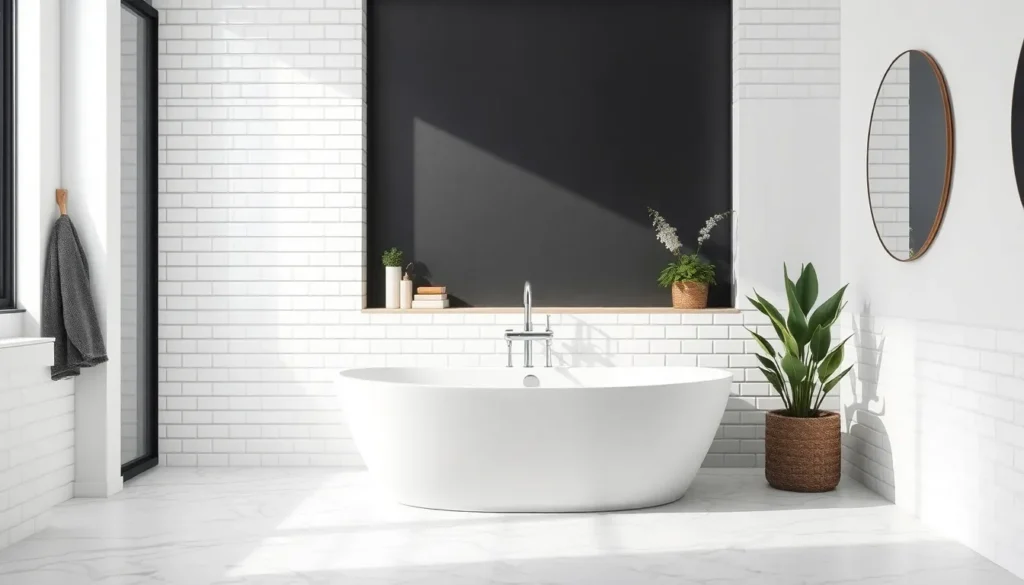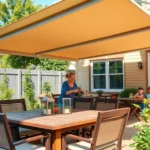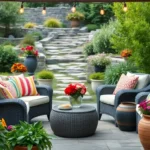When it comes to transforming your bathroom, few design elements pack as much visual punch as the right tile choices. We’ve all stood in outdated bathrooms wondering how a simple material change could breathe new life into the space – and the answer lies in selecting tiles that perfectly balance style, functionality, and your personal aesthetic.
Today’s tile market offers an incredible array of options that go far beyond basic subway tiles. From bold geometric patterns that create stunning focal points to luxurious natural stone that brings spa-like tranquility, we’re seeing homeowners embrace tiles as their primary design statement. Whether you’re planning a complete renovation or a strategic refresh, the right tiles can instantly elevate your bathroom from ordinary to extraordinary.
We’ll explore the hottest tile trends, practical considerations for different bathroom sizes, and creative installation techniques that maximize visual impact while staying within your budget.
Classic Subway Tile Designs for Timeless Appeal
Subway tiles continue to dominate bathroom design choices because they offer versatility that adapts to any decorating style. We’ve seen these rectangular ceramic tiles transform countless bathrooms from basic to beautiful.
Traditional White Subway Tiles
White subway tiles create the perfect foundation for bathroom tile ideas that never go out of style. These 3×6 inch rectangular tiles deliver clean lines and bright surfaces that make small bathrooms appear larger. We recommend using white grout for seamless looks or dark grout for dramatic contrast that highlights each tile’s shape.
Installing white subway tiles in standard brick patterns works beautifully behind vanities and in shower surrounds. The glossy finish reflects light throughout the space while the neutral color complements any fixture finish from chrome to brass. We often pair these tiles with marble countertops or wooden vanities to create balanced designs that feel both classic and fresh.
Maintenance becomes effortless with white subway tiles since their smooth surface resists stains and soap buildup. Professional installation typically costs $8 to $15 per square foot including materials and labor.
Colored Subway Tile Variations
Colored subway tiles bring personality to bathroom spaces while maintaining that timeless rectangular shape we love. Popular color choices include sage green, navy blue, charcoal gray, and soft pink that create focal points without overwhelming smaller rooms. We’ve noticed homeowners gravitating toward matte finishes in colored tiles for sophisticated looks.
Deep emerald green subway tiles paired with brass fixtures create luxurious spa environments. Soft blue variations work perfectly in coastal themed bathrooms when combined with white trim and natural wood elements. We suggest limiting colored subway tiles to accent walls or shower niches to prevent color fatigue over time.
Pricing for colored subway tiles ranges from $3 to $12 per square foot depending on the manufacturer and finish quality. These tiles coordinate beautifully with white subway tiles for two tone designs that add visual interest.
Herringbone and Vertical Subway Patterns
Herringbone patterns using subway tiles create ever-changing visual movement that transforms ordinary bathroom walls into design statements. This zigzag installation technique works especially well in shower surrounds where the pattern draws eyes upward. We recommend hiring experienced installers for herringbone layouts since precise measurements ensure professional results.
Vertical subway tile installations make bathroom ceilings appear higher while creating modern streamlined aesthetics. Installing tiles vertically costs the same as horizontal layouts but requires careful planning to avoid awkward cuts at ceiling lines. We often combine vertical subway tiles with horizontal accent strips for balanced compositions.
Diagonal subway tile patterns offer another creative installation option that adds sophistication to powder rooms and master bathrooms. These geometric arrangements work best in larger spaces where the full pattern becomes visible without appearing cluttered.
Natural Stone Tile Options for Luxury Bathrooms

Natural stone tiles elevate bathroom design to new heights of sophistication and luxury. We’ve carefully selected the most stunning natural stone options that transform ordinary bathrooms into spa-like retreats.
Marble Tiles for Elegant Sophistication
Marble tiles deliver unmatched luxury and timeless elegance to any bathroom space. Varieties like Carrara White and Calacatta Gold showcase stunning veining patterns that create natural artwork on your walls and surfaces.
Best applications for marble tiles include bathroom walls and vanity areas where their beauty truly shines. We recommend using honed marble over polished marble for bathroom floors since it provides better slip resistance and safety.
Durability makes marble an excellent long-term investment for luxury bathroom renovations. The natural stone’s renowned strength ensures your beautiful bathroom will maintain its elegance for decades with proper care.
Travertine Tiles for Rustic Charm
Travertine tiles bring natural, earthy appeal that creates a warm and inviting bathroom atmosphere. This natural stone offers a rustic charm that’s perfect for homeowners seeking organic texture and visual interest.
Porosity requires regular sealing to maintain water and stain resistance in bathroom environments. We suggest applying sealant annually to protect your travertine investment and preserve its natural beauty.
Textured surfaces provide the natural, organic look that many homeowners desire in their bathroom design. The stone’s unique patterns and variations ensure no two installations look exactly alike.
Slate Tiles for Modern Minimalism
Slate tiles offer a sleek, modern aesthetic with their dark appearance and clean lines. This natural stone perfectly complements contemporary bathroom designs that emphasize minimalist elegance.
Moisture resistance makes slate an ideal choice for bathroom floors where water exposure is constant. The stone’s natural properties provide excellent protection against bathroom humidity and splashing.
Stain resistance ensures your slate bathroom floors maintain their sophisticated appearance with minimal maintenance. While occasional sealing helps preserve the stone, slate naturally resists most bathroom stains and spills.
Durability guarantees long-lasting performance in high-traffic bathroom areas. Slate’s exceptional strength makes it suitable for both residential and commercial bathroom applications.
Bold Pattern Tiles to Make a Statement

Bold patterned bathroom tiles are transforming spaces into stunning focal points in 2025. These statement making designs offer everything from vintage inspired floral motifs to striking geometric shapes that bring personality and visual interest to your bathroom walls and floors.
Geometric Hexagon Tile Designs
Geometric hexagon tiles create visually striking layouts that add modern sophistication to any bathroom space. We love how these six sided shapes can be arranged in countless patterns, from classic honeycomb formations to mixed arrangements that create ever-changing visual flow throughout the room.
Hexagon tiles work particularly well in powder rooms and small bathrooms where their unique shape draws the eye upward, making spaces feel larger than they actually are. Consider using larger hexagon tiles in neutral tones for flooring, while smaller versions in bold colors create stunning accent walls behind vanities or in shower niches.
The versatility of hexagon tile designs allows us to experiment with color combinations and finishes that complement existing bathroom fixtures. Matte black hexagons paired with white grout create dramatic contrast, while soft gray hexagons with matching grout offer subtle texture without overwhelming the space.
Moroccan Inspired Mosaic Patterns
Moroccan inspired mosaic patterns bring vibrant colors and intricate designs that transform ordinary bathrooms into exotic retreats. These tiles often feature traditional motifs reminiscent of Italian Majolica styles, offering rich cultural heritage combined with modern manufacturing techniques.
We’re seeing increased demand for sustainable mosaic options made from at least 20% recycled materials, proving that eco friendly choices don’t compromise on beauty or durability. The intricate patterns typically include star and cross formations, geometric florals, and arabesque designs that create mesmerizing visual texture.
Installation of Moroccan mosaic tiles works best as feature walls or backsplashes rather than covering entire rooms, allowing the detailed patterns to serve as artistic focal points. Consider using these ornate tiles sparingly in powder rooms or as accent strips in larger bathrooms to avoid visual overwhelm while maintaining their stunning impact.
Art Deco Diamond and Triangle Motifs
Art Deco diamond and triangle motifs add luxury and sophistication through bold geometric patterns that define the glamorous 1920s aesthetic. These angular designs create striking visual interest when incorporated into mixed shape layouts, which are gaining important popularity in 2025 bathroom design trends.
Diamond shaped tiles can be arranged in traditional grid patterns or rotated to create ever-changing chevron effects that elongate walls and add movement to static surfaces. Triangle tiles offer even more creative possibilities, allowing us to design custom patterns that range from subtle geometric textures to bold statement walls.
We recommend using Art Deco motifs in monochromatic color schemes to let the geometric shapes take center stage, or incorporating metallic accents like gold or brass grout to enhance the luxurious feel. These patterns work exceptionally well in master bathrooms and powder rooms where their sophisticated aesthetic can be fully appreciated without competing with other design elements.
Large Format Tiles for Spacious Visual Impact
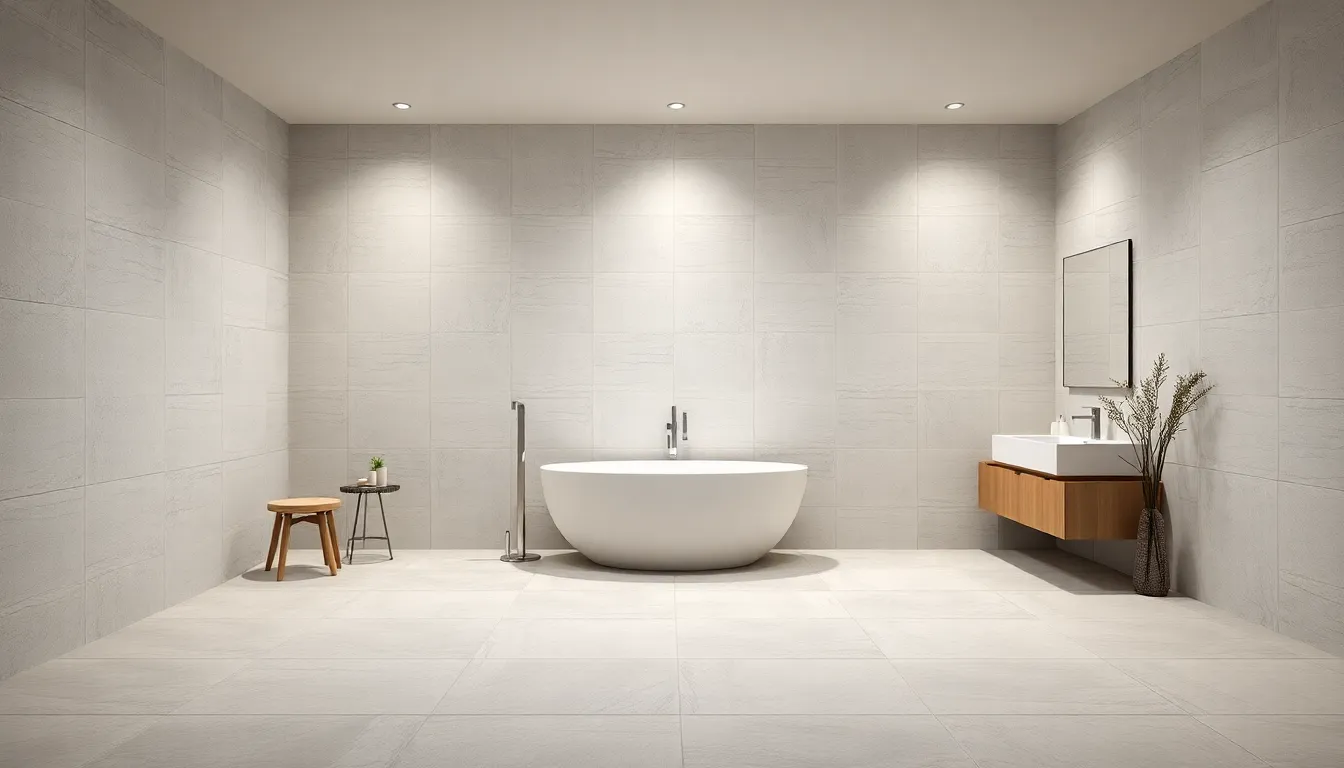
Moving beyond intricate patterns, we’re seeing a shift toward larger tiles that create dramatic spatial transformations. These oversized formats, typically measuring 12 inches by 24 inches or larger, revolutionize how we perceive bathroom dimensions through their expansive surface coverage.
Oversized Porcelain Tile Benefits
Porcelain tiles in oversized formats deliver unmatched performance for bathroom environments. Their water absorption rate stays below 0.5%, making them virtually impervious to moisture damage that plagues other materials. Durability becomes exceptional with these tiles, as they withstand heavy foot traffic while resisting scratches and stains that typically affect bathroom surfaces.
Hygiene maintenance reaches new levels of simplicity with oversized porcelain options. We find cleaning becomes effortless since fewer grout lines mean fewer places for germs and grime to accumulate. Slip resistance improves when manufacturers apply specialized finishes, creating safer walking surfaces without compromising the sleek aesthetic.
Wall-to-Wall Large Tile Installation
Strategic installation from wall to wall amplifies the spacious effect these tiles naturally create. This comprehensive approach eliminates visual interruptions that smaller tile formats introduce through frequent pattern breaks. Cohesive flow develops throughout the entire space when we extend the same large format across floors and up shower walls.
Professional installation becomes crucial for achieving the seamless look that makes this technique so effective. We recommend hiring experienced contractors who understand the precision required for large format alignment. Proper substrate preparation ensures tiles remain level and stable over time, preventing the lippage issues that can occur with oversized materials.
Minimizing Grout Lines for Clean Aesthetics
Grout color selection dramatically impacts the final visual result when working with large format tiles. We achieve the most spacious appearance by matching grout tones closely to the tile color, creating an almost seamless surface. This technique works particularly well with neutral porcelain tiles in whites, grays, and beiges.
Rectified edges on large format tiles allow for extremely narrow grout lines, sometimes as thin as 1/16 inch. These minimal gaps contribute to the clean, uninterrupted appearance that makes bathrooms feel significantly larger. Regular sealing of these narrow grout lines maintains the pristine look while protecting against moisture penetration and staining.
Textured Tile Surfaces for Added Dimension

We’re witnessing a important shift toward textured tiles that create visual depth and tactile interest in bathroom spaces. These innovative surfaces transform flat walls into ever-changing design elements that captivate the eye and enhance the overall bathroom experience.
3D Raised Pattern Tiles
3D Raised Pattern Tiles deliver the most pronounced visual impact among textured options. These architectural elements feature elevated designs that cast shadows and create depth even in the smallest bathrooms. We recommend installing them on accent walls to avoid overwhelming the space while maximizing their dramatic effect.
Geometric patterns dominate the 3D tile market with options like hexagonal honeycomb designs and wave formations. These tiles work exceptionally well behind vanities or in shower niches where they can serve as stunning focal points. Installation requires careful planning since the raised surfaces need adequate clearance from fixtures.
Lighting considerations become crucial with 3D tiles since shadows enhance their dimensional qualities. We suggest incorporating LED strip lighting or wall sconces to highlight the texture patterns and create ambient lighting effects throughout the day.
Wood-Look Ceramic Tile Options
Wood-look ceramic tiles combine natural beauty with practical durability in bathroom environments. These tiles mimic authentic wood grain patterns while offering superior moisture resistance that traditional hardwood cannot match. We’ve seen increasing demand for these tiles as homeowners seek warm organic aesthetics without maintenance concerns.
Plank sizes vary from narrow strips resembling reclaimed barn wood to wide luxury boards that create contemporary spa-like atmospheres. Popular finishes include weathered oak, rustic pine, and sophisticated walnut tones that complement various design schemes. These tiles install using standard ceramic techniques while delivering the visual warmth of natural wood.
Maintenance advantages make wood-look ceramics particularly appealing for busy households. Unlike real wood, these tiles resist water damage, scratches, and staining while requiring only basic cleaning routines. We recommend choosing rectified edges for minimal grout lines that enhance the authentic wood appearance.
Brick-Effect Tiles for Industrial Style
Brick-effect tiles create authentic industrial aesthetics without the structural limitations of real masonry. These tiles capture the rugged charm of exposed brick walls while maintaining the practical benefits of modern ceramic construction. We’re seeing renewed interest in industrial design elements as homeowners embrace urban loft aesthetics.
Installation patterns significantly impact the final appearance of brick-effect tiles. Running bond patterns create traditional looks while herringbone arrangements add sophisticated complexity. We suggest using contrasting grout colors to emphasize the individual brick appearance and enhance the authentic texture.
Color variations range from classic red brick to modern white-washed finishes and dramatic charcoal tones. Weathered brick effects with varied coloring create the most realistic appearances and work particularly well in vintage-inspired bathroom designs. These tiles pair excellently with industrial fixtures like matte black faucets and exposed pipe elements.
Creative Color Combinations and Contrasts
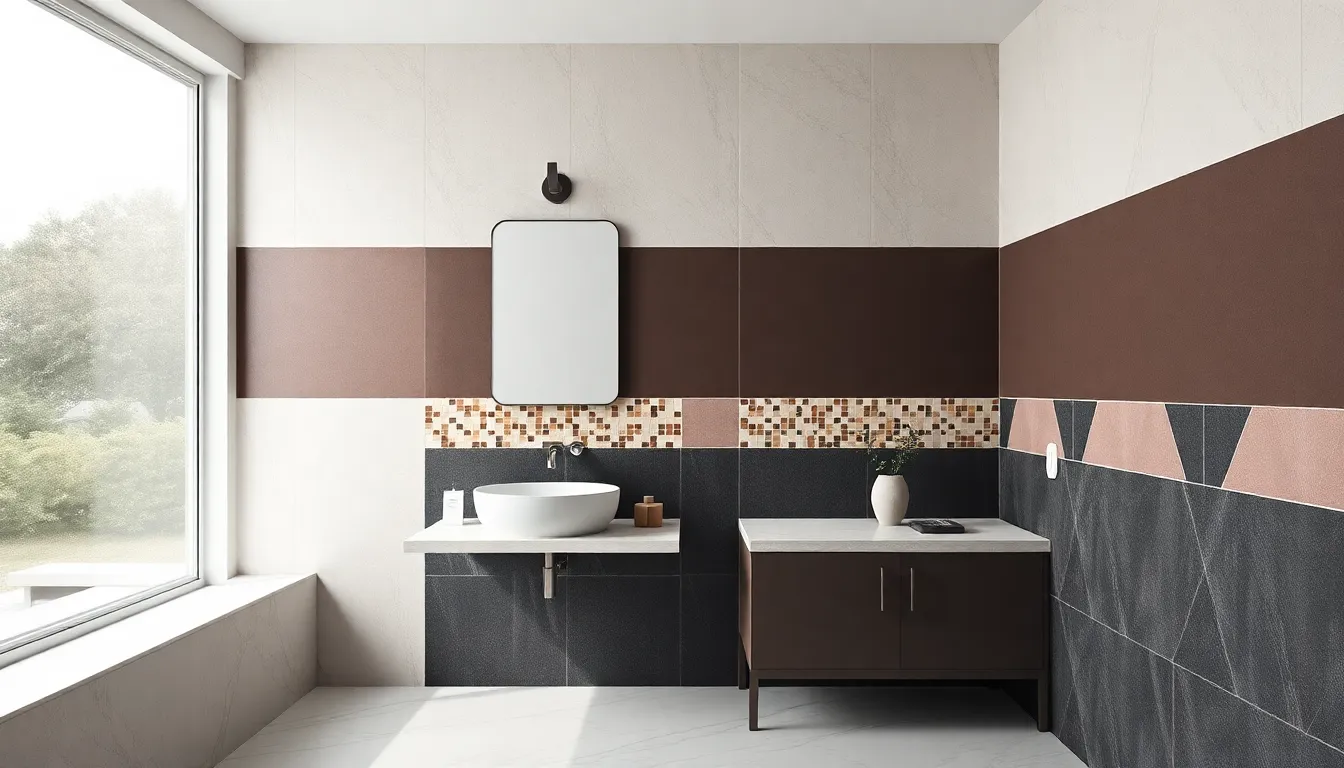
Bold geometric shapes and vintage-inspired patterns are transforming bathroom tile designs in 2025. We’re seeing homeowners embrace mixing colors and textures to create visually striking spaces that serve as design centerpieces.
Monochromatic Tile Schemes
Refined monochrome approaches continue to dominate sophisticated bathroom designs. We recommend moving beyond stark all-white spaces toward warm neutrals and soft organic colors that create calm, unified atmospheres. Marble-effect tiles offer elegant answers with natural veining patterns in off-white shades, providing luxury appeal with minimal maintenance requirements.
Subtle tone variations within monochromatic schemes add depth without overwhelming smaller spaces. Porcelain tiles in matching color families create seamless transitions from floor to wall. Modern interpretations emphasize texture over color contrast, using surfaces like honed finishes or subtle embossed patterns to maintain visual interest.
Two-Tone Accent Wall Designs
Strategic two-tone installations introduce visual interest through complementary color pairings. We suggest applying dark tones or bold hues to lower walls or shower areas while keeping upper sections light and neutral. This approach creates depth and modern appeal, especially when paired with textured or fluted tile surfaces for extra dimension.
Contemporary designs often feature neutral bases with single accent walls in coordinating colors. Complementary combinations work effectively in larger bathrooms, while subtle tonal shifts suit compact spaces better. Fluted tiles add architectural interest to two-tone designs, creating shadow lines that enhance the color contrast effect.
Bold Color Pop Tile Features
Vibrant accent features are transforming neutral bathroom backgrounds into stylish retreats. We’re incorporating bold blues, greens, pinks, and purples through single statement walls, decorative niches, or mosaic borders. These color pops add personality without overwhelming the overall design scheme.
Italian Majolica-inspired patterns and Moroccan-style motifs deliver creative color contrasts in porcelain and ceramic formats. Accent strips work particularly well around mirrors or within shower areas, breaking up monotonous surfaces with geometric shapes. Statement patterns create visual centerpieces while maintaining practical moisture-resistant properties essential for bathroom environments.
Small Space Tile Solutions for Compact Bathrooms
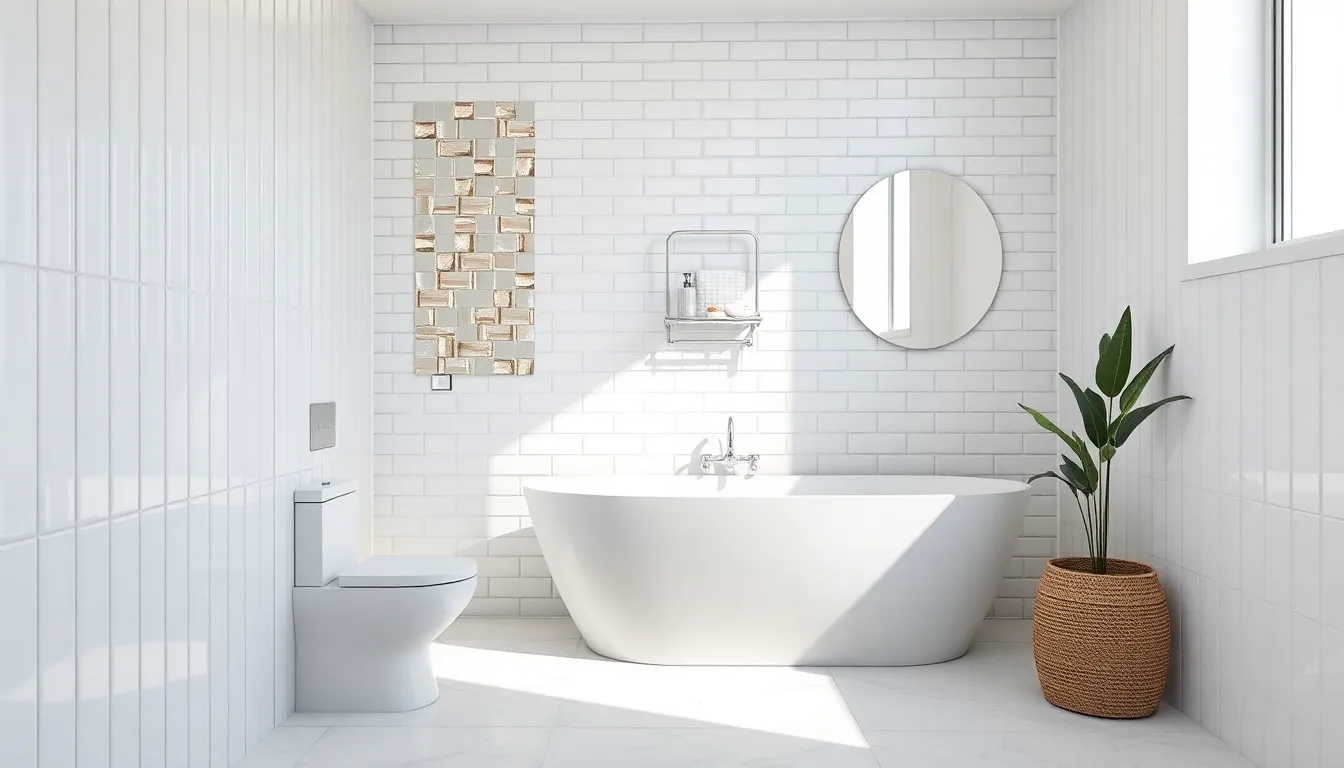
Compact bathrooms present unique design challenges that require strategic tile selection to maximize visual space. We’ll explore proven techniques that transform cramped quarters into seemingly spacious sanctuaries.
Light-Colored Tiles to Expand Space
Light-colored tiles create an illusion of larger space by reflecting light throughout your compact bathroom. White, cream, and pale gray tiles remain the most popular choices for this space-improving effect. We recommend using these neutral tones on walls and floors to maintain visual continuity that makes boundaries less defined.
Glossy finishes amplify the light reflection properties of pale tiles, doubling their space-expanding impact. Porcelain tiles in soft ivory or warm white offer exceptional durability while maintaining that crucial brightness factor. Consider extending light colored tiles from floor to ceiling to eliminate visual breaks that can make small spaces feel chopped up.
Textured light tiles add subtle interest without sacrificing the brightness we need in compact spaces. Marble-effect tiles in white or cream provide luxury appeal while keeping surfaces light and airy. Large format light tiles reduce grout lines, creating cleaner expanses that further enhance the spacious feeling.
Vertical Tile Patterns for Height
Vertical installation creates the illusion of higher ceilings, making compact bathrooms feel more spacious regardless of tile color. This technique works exceptionally well with both light and dark colored tiles, offering flexibility in your design choices. We suggest using rectangular tiles installed vertically to maximize this height improving effect.
Subway tiles positioned vertically rather than horizontally draw the eye upward, creating dramatic ceiling lift in small spaces. Stack bonding patterns work better than offset patterns for achieving maximum vertical emphasis. Consider running vertical tiles all the way to the ceiling to eliminate horizontal lines that can visually lower the room.
Wood-look tiles installed vertically mimic the appearance of board and batten wainscoting while adding perceived height. Narrow format tiles, such as 3×12 inch planks, create stronger vertical lines than wider options. Color gradation from darker floor tiles to lighter wall tiles enhances the upward visual movement we’re trying to achieve.
Mirror Tiles for Reflection Effects
Mirror tiles reflect light and images, creating an illusion of expanded space through their reflective properties. These specialized tiles work strategically when placed opposite windows or light sources to amplify natural illumination. We recommend using mirror tiles as accent features rather than covering entire walls to avoid overwhelming small spaces.
Antiqued mirror tiles provide reflection benefits while adding vintage character that feels less clinical than standard mirrors. Small mosaic mirror tiles create sparkle and movement without the stark appearance of large mirror sheets. Consider installing mirror tiles on one accent wall or in a shower niche to maximize their space expanding impact.
Beveled edge mirror tiles add dimension and visual interest while maintaining their reflective qualities. These tiles work particularly well in powder rooms or half baths where dramatic effect is desired. Mixing mirror tiles with other reflective surfaces like glass or polished stone creates layered reflection that amplifies the spacious feeling throughout your compact bathroom.
Budget-Friendly Tile Ideas Without Compromising Style
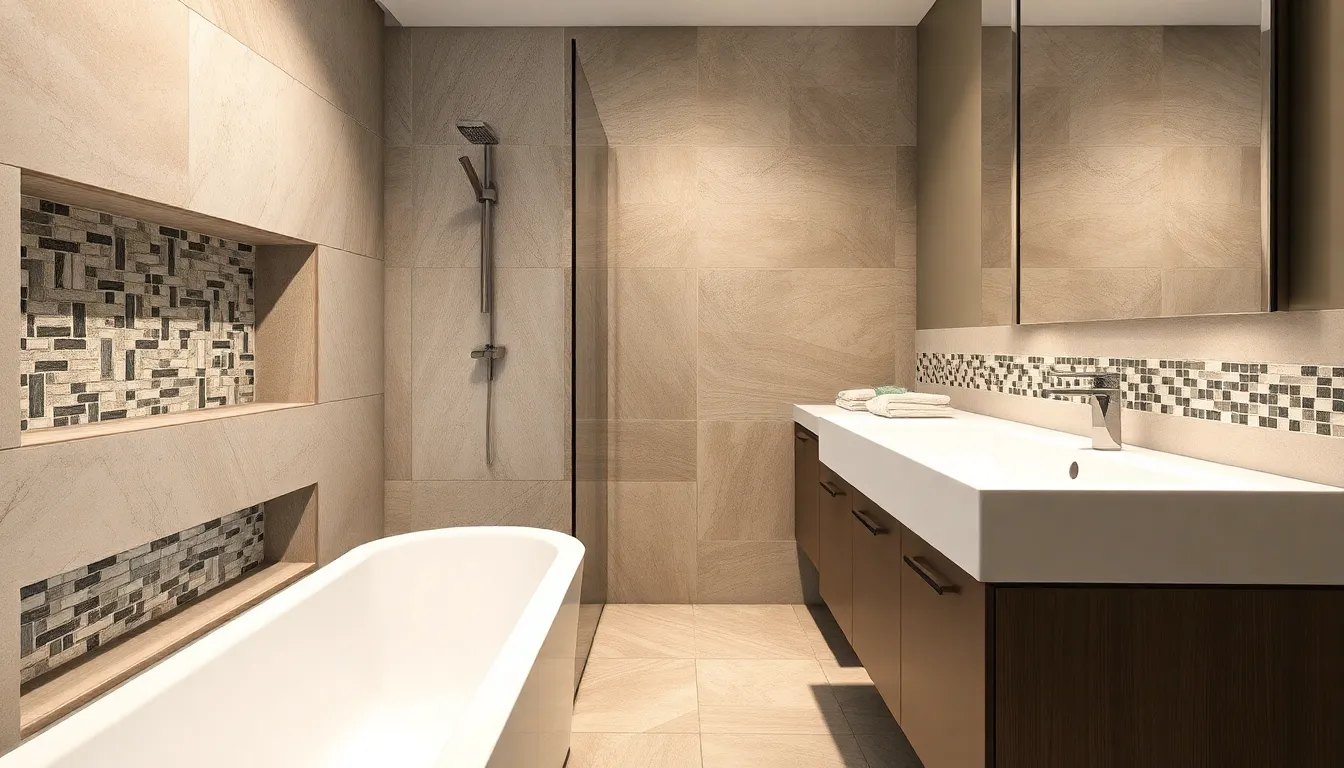
Creating a stunning bathroom doesn’t require very costly when you choose the right tile options. We’ve discovered that smart material choices and strategic placement can deliver high-end looks at fraction of traditional costs.
Ceramic Tile Alternatives to Natural Stone
Ceramic tiles offer incredible versatility and can convincingly mimic various natural stone designs at significantly lower prices. These affordable options provide the same visual impact as premium materials while maintaining excellent durability for bathroom environments. We recommend exploring ceramic tiles that replicate marble, granite, and limestone textures since they deliver authentic appearances without the hefty price tags.
Porcelain tiles excel in both durability and design flexibility, making them superior alternatives to natural stone installations. Their moisture resistance surpasses many traditional materials, and modern manufacturing techniques create remarkably realistic stone textures. We’ve seen porcelain options that perfectly capture travertine’s rustic charm and slate’s contemporary appeal at 60-70% lower costs than genuine stone.
Marble effect tiles bring luxurious sophistication to bathrooms without the maintenance concerns of real marble. These engineered surfaces resist staining and etching while providing the elegant veining patterns that make marble so desirable. We particularly favor large format marble effect tiles that minimize grout lines and maximize the authentic appearance.
DIY-Friendly Peel and Stick Options
Peel and stick tiles revolutionize bathroom renovations by eliminating complex installation processes and professional labor costs. These innovative products adhere directly to existing surfaces, making them perfect for weekend DIY projects that transform spaces quickly. We’ve found that modern peel and stick options now include realistic stone patterns, geometric designs, and even subway tile aesthetics.
Application versatility makes peel and stick tiles ideal for renters and homeowners seeking temporary or budget conscious updates. They work effectively on painted walls, existing tile surfaces, and smooth concrete, requiring minimal surface preparation. We recommend choosing water resistant varieties specifically designed for bathroom environments to ensure long lasting adhesion.
Pattern variety in peel and stick tiles now rivals traditional ceramic options, with Moroccan inspired designs, hexagonal shapes, and wood grain textures available. These self adhesive tiles typically cost $2-5 per square foot compared to $8-15 for professional ceramic installation. We suggest combining different patterns strategically to create custom accent features without professional design costs.
Strategic Accent Tile Placement
Accent walls transform ordinary bathrooms into design showcases by concentrating bold or patterned tiles on single focal surfaces. This approach allows you to incorporate expensive designer tiles affordably since you’re covering limited square footage. We recommend choosing the wall behind the vanity or opposite the entrance for maximum visual impact.
Shower niches provide perfect opportunities for decorative tile placement that adds personality without overwhelming the space. These recessed areas typically require only 2-4 square feet of specialty tiles, making premium options financially accessible. We often suggest using mosaic or hand painted tiles in shower niches to create jewelry like focal points.
Backsplashes behind sinks and toilets offer another strategic location for accent tile installation that maximizes visual interest. These smaller areas let you experiment with geometric patterns, metallic finishes, or artisan tiles that would be cost prohibitive for entire walls. We’ve found that even 6-12 square feet of statement tiles can completely transform a bathroom’s aesthetic while staying within modest budgets.
Conclusion
Your bathroom transformation is within reach with the right tile choices. We’ve explored everything from timeless subway patterns to bold geometric designs that can turn your space into a stunning retreat.
Whether you’re working with a compact powder room or a spacious master bath the key lies in strategic selection. Natural stone brings luxury while large format tiles create seamless sophistication. For budget-conscious renovators peel and stick options offer style without very costly.
The trends we’ve covered for 2025 show that textured surfaces and creative patterns are here to stay. Don’t be afraid to mix materials or play with contrasts – your bathroom should reflect your personal style while maintaining functionality.
Start with one focal area and build from there. With these tile ideas as your foundation you’re ready to create a bathroom that’s both beautiful and practical for years to come.
Frequently Asked Questions
What makes subway tiles a popular choice for bathroom design?
Subway tiles remain popular due to their timeless versatility and clean aesthetic. Traditional white subway tiles create clean lines, make small bathrooms appear larger, and are easy to maintain with their smooth surfaces. They can be installed in creative patterns like herringbone or vertical arrangements, and colored variations add personality while maintaining classic appeal.
Which natural stone tiles work best for bathroom applications?
Marble tiles like Carrara White and Calacatta Gold offer elegant sophistication, with honed marble recommended for floors due to slip resistance. Travertine provides rustic charm but requires regular sealing. Slate tiles deliver modern minimalism with excellent moisture resistance and durability, making them ideal for high-traffic bathroom areas.
How do large format tiles transform bathroom spaces?
Large format tiles (12×24 inches or larger) create dramatic spatial transformations by enhancing the perception of space through expansive surface coverage. They feature fewer grout lines for easier maintenance, and oversized porcelain options offer low water absorption and exceptional durability. Professional installation ensures precision and wall-to-wall coverage for maximum impact.
What are the benefits of textured tile surfaces in bathrooms?
Textured tiles add visual depth and tactile interest to bathroom spaces. 3D raised pattern tiles create dramatic accent walls when properly lit, while wood-look ceramic tiles combine natural beauty with moisture resistance. Brick-effect tiles provide industrial aesthetics without real masonry limitations, offering various installation patterns and color options.
How can small bathrooms benefit from strategic tile selection?
Small bathrooms benefit from light-colored tiles in white, cream, or pale gray that create illusions of larger spaces. Glossy finishes amplify light reflection, while vertical tile patterns enhance perceived height. Mirror tiles reflect light and expand visual space, with antiqued and beveled options adding character without overwhelming compact areas.
What are budget-friendly tile options that don’t compromise style?
Ceramic tiles offer versatile, affordable alternatives to natural stone with realistic designs and durability. Porcelain tiles provide moisture resistance with realistic stone textures. Marble-effect tiles deliver luxury aesthetics without maintenance concerns. DIY-friendly peel-and-stick tiles enable easy renovations without professional labor costs, perfect for renters and budget-conscious homeowners.
Which bold patterned tiles are trending in 2025?
Geometric hexagon tiles lead 2025 trends with modern sophistication and space-enhancing properties. Moroccan-inspired mosaic patterns bring vibrant colors and intricate designs, with sustainable options available. Art Deco diamond and triangle motifs add luxury through bold geometric patterns, working best in monochromatic schemes or with metallic accents for sophisticated appeal.
How should accent tiles be strategically placed for maximum impact?
Strategic accent tile placement maximizes visual impact in areas like shower niches, backsplashes, and feature walls. This approach allows for decorative tiles that transform bathroom aesthetics affordably while keeping the majority of surfaces neutral. Focus on high-visibility areas where bold patterns or textures can create focal points without overwhelming the space.

